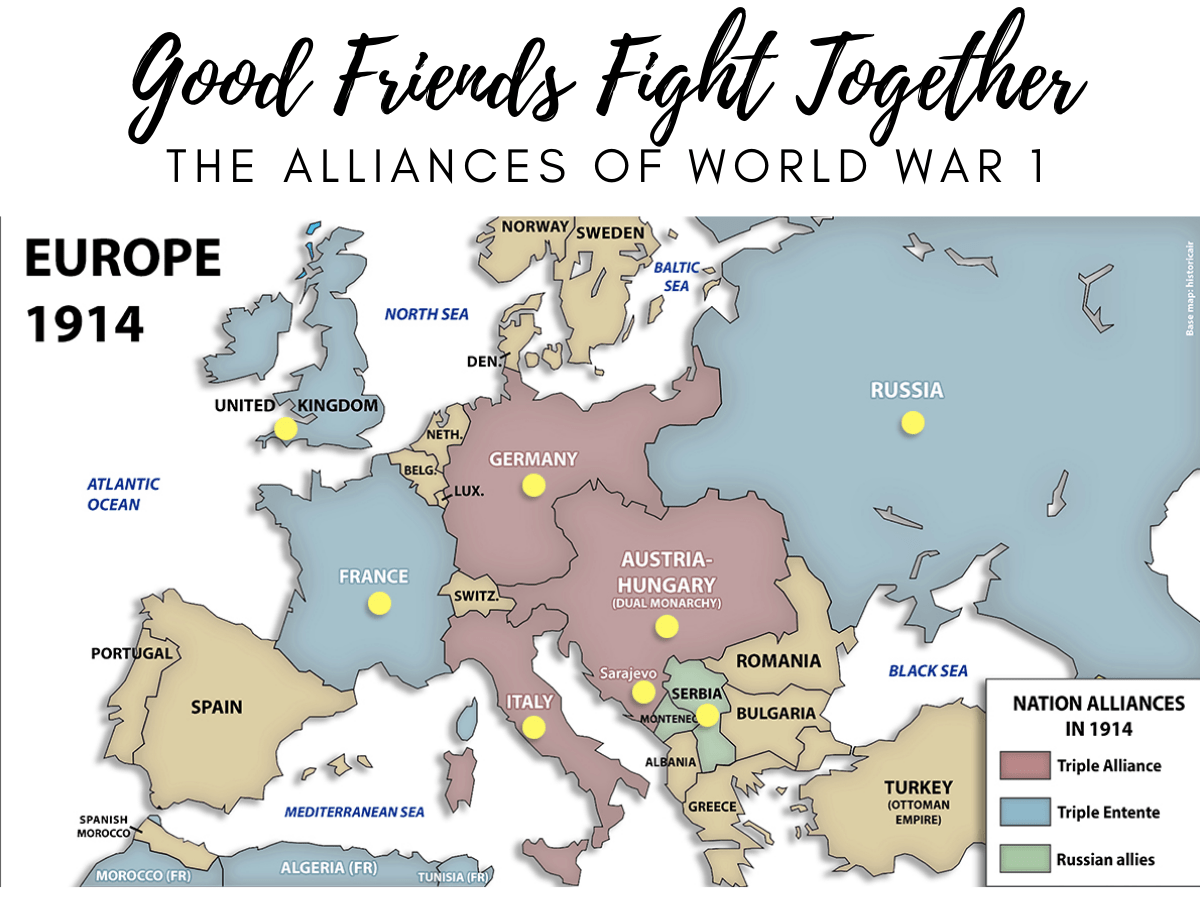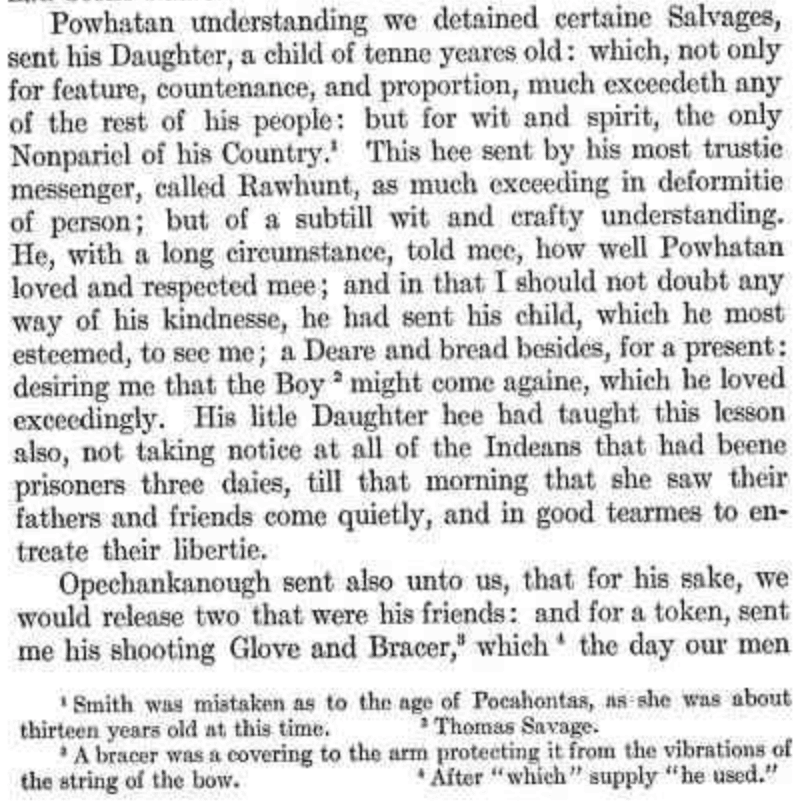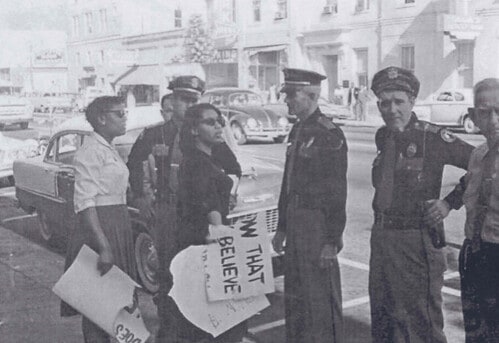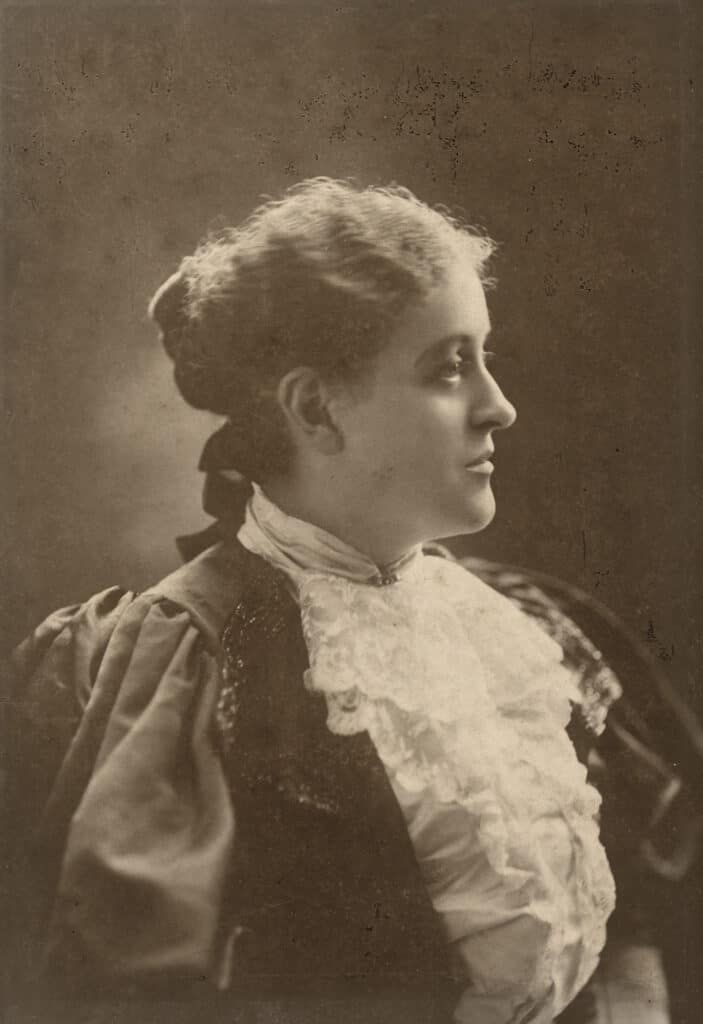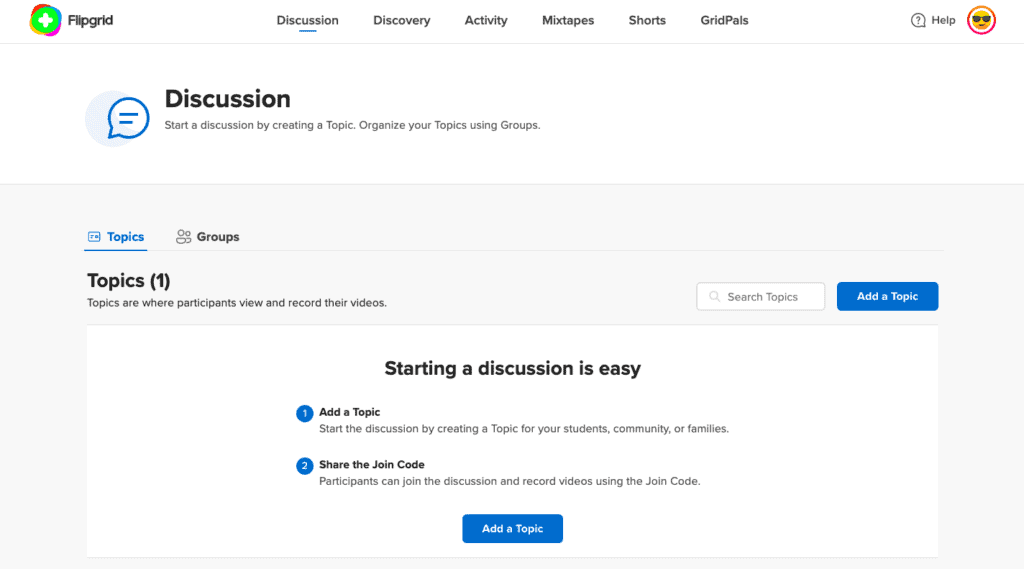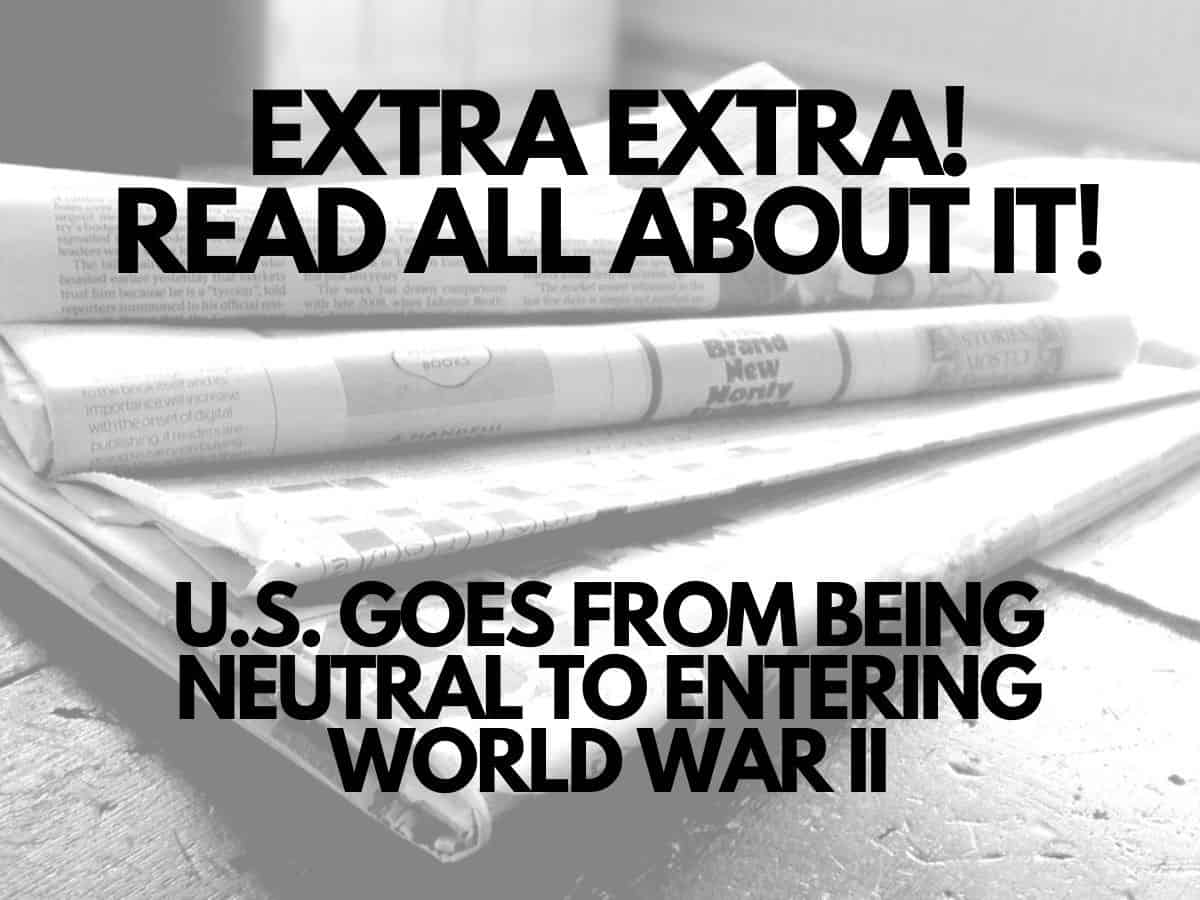Featured Image: Source
Introduction of this Document-Based Lesson:
Historical Context:
Alliances between various European nations leading up to 1914 was one of the leading causes of World War 1. After the assassination of Austrian Archduke Franz Ferdinand in June 1914, Europe was thrust into chaos, and each country had call upon their alliances and decide which side of the war to join.
Classroom Context:
This lesson is designed for a 9th grade Modern World History class during Comprehensive Distance Learning (CDL). This class just finished a unit about European imperialism in the 19th and early 20th Centuries, which thematically and chronologically leads into this new unit about WWI. This activity introduces the causes of WWI and can be delivered synchronously or asynchronously during CDL on the first day of the unit.
Essential Questions:
How did European alliances prior to WWI shape the course of the war?
How do relationships between individual nations affect larger global events?
In this lesson, students will examine various primary source documents to determine each country’s alliances and rationale for picking their side in this Great War. They will build historical thinking skills of chronological thinking (cause and effect), specifically examining the role of alliances in the escalation of the conflict from the assassination of Archduke Franz Ferdinand to various countries declaring war.
Next Steps: This lesson will prepare students for the following class, which will cover the events and battles immediately following the outbreak of war in 1914. Knowledge of the key actors and alliances gained during this lesson will be vital in understanding the interactions between the two sides of the war.
Google Forms Activity:
This lesson is delivered via a differentiated Google Form. This allows students to “choose their own adventure” by determining the order in which they progress through the countries; however, students will examine all 7 documents before submitting the form. They will first begin by reading a page of context about the state of Europe and the assignation of Franz Ferdinand, then they will decide whether to begin with Serbia or with Austria-Hungary. Depending on their choice, the Google Form will progress as follows:
Track 1: Serbia –> Russia –> France –> Great Britain –> Track 2
OR
Track 2: Austria-Hungary –> Germany –> Italy –> Track 1
Each page includes a primary source document (image, political cartoon, treaty, etc.) describing that country’s alliances and motivations. Students will examine each source and then answer 2-3 scaffolding analysis questions. When they finish which the questions, they will advance onto the next country’s page.
For ease of access, each country’s context, primary source, and questions are also included on this page below.
Country 1: Serbia
Context: The Balkans (where Serbia is) has been an area of particular instability. The decline of the Ottoman Empire and the increasing power of Austria-Hungary have led to battle to control the region. In 1908-09 your neighboring Slavic country, Bosnia, was taken over by Austria-Hungary. You fear and hate Austria-Hungary as a threat to your national identity. You know that any day now there is going to be an almighty fight. As you are small and weak country, you rely on your connections to Russia to protect you. After Austrian Archduke Franz Ferdinand was assassinated on your soil, Austria-Hungary sent you an ultimatum (a final demand).
Primary Source: “The Austro-Hungarian Ultimatum to Serbia– English Translation,” sent to Serbia on July 23, 1914
Vienna, July 22, 1914
Your Excellency will present the following note to the Royal Government on the afternoon of Thursday, July 23: On the 31st of March, 1909, the Royal Serbian Minister at the Court of Vienna made, in the name of his Government, the following declaration to the Imperial and Royal Government:
[…]
The results brought out by the inquiry no longer permit the Imperial and Royal Government to maintain the attitude of patient tolerance which it has observed for years toward those agitations which center at Belgrade and are spread thence into the territories of the Monarchy. Instead, these results impose upon the Imperial and Royal Government the obligation to put an end to those intrigues, which constitute a standing menace to the peace of the Monarchy.
In order to attain this end, the Imperial and Royal Government finds itself compelled to demand that the Serbian Government give official assurance that it will condemn the propaganda directed against Austria-Hungary, that is to say, the whole body of the efforts whose ultimate object it is to separate from the Monarchy territories that belong to it; and that it will obligate itself to suppress with all the means at its command this criminal and terroristic propaganda. In order to give these assurances a character of solemnity, the Royal Serbian Government will publish on the first page of its official organ of July 26/13, the following declaration:
“The Royal Serbian Government condemns the propaganda directed against Austria-Hungary, that is to say, the whole body of the efforts whose ultimate object it is to separate from the Austro- Hungarian Monarchy territories that belong to it, and it most sincerely regrets the dreadful consequences of these criminal transactions.
“The Royal Serbian Government regrets that Serbian officers and officials should have taken part in the above-mentioned propaganda and thus have endangered the friendly and neighborly relations, to the cultivation of which the Royal Government had most solemnly pledged itself by its declarations of March 31, 1909.
“The Royal Government, which disapproves and repels every idea and every attempt to interfere in the destinies of the population of whatever portion of Austria-Hungary, regards it as its duty most expressly to call attention of the officers, officials, and the whole population of the kingdom to the fact that for the future it will proceed with the utmost rigor against any persons who shall become guilty of any such activities, activities to prevent and to suppress which, the Government will bend every effort.”
[…]
Analysis Questions:
- What is the Austrian government’s purpose in creating this document? (Why are they writing this?)
- What are the 3 main things that Austria-Hungary demands that Serbia do?
- Serbia ended up rejecting this ultimatum. Based on this document, how do you predict Austria-Hungary reaction to this rejection?
Country 2: Russia
Context: Throughout the 18th and 19th centuries, many countries have been expanding their empires, in order to increase their wealth. The newly formed Germany, and their central European neighbor, Austria-Hungary, appear to be growing close and this could potentially threaten your western borders. You also feel a responsibility to Serbia, who looks up to you as a powerful Slavic nation.
Primary Source: “Telegram from Alexander, Prince Regent of Serbia to the Tsar of Russia, “Source Records of the Great War, Vol. I, ed. Charles F. Horne, National Alumni 1923. Source
Belgrade, July 24, 1914
The Austro-Hungarian Government yesterday evening handed to the Serbian Government a note concerning the “attentat” of Serajevo.
Conscious of its international duties, Serbia from the first days of the horrible crime declared that she condemned it, and that she was ready to open an inquiry on her territory if the complicity of certain of her subjects were proved in the investigation begun by the Austro-Hungarian authorities.
However, the demands contained in the Austro-Hungarian note are unnecessarily humiliating for Serbia and incompatible with her dignity as an independent State.
Thus we are called upon in peremptory tones for a declaration of the Government in the “Official journal,” and an order from the Sovereign to the army wherein we should repress the spirit of hostility against Austria by reproaching ourselves for criminal weakness in regard to our perfidious actions.
Then we have to admit Austro-Hungarian functionaries into Serbia to participate with our own in the investigation and to superintend the execution of the other conditions indicated in the note.
We have received a time-limit of forty-eight hours to accept everything, in default of which the legation of Austria-Hungary will leave Belgrade. We are ready to accept the Austro-Hungarian conditions which are compatible with the position of an independent State as well as those whose acceptance shall be advised us by your Majesty.
All persons whose participation in the “attentat” shall be proved will be severely punished by us. Certain of these demands cannot be carried out without changes in our legislation, which require time. We have been given too short a limit. We can be attacked after the expiration of the time-limit by the Austro-Hungarian Army which is concentrating on our frontier.
It is impossible for us to defend ourselves, and we supplicate your Majesty to give us your aid as soon as possible. The highly prized good will of your Majesty, which has so often shown itself toward us, makes us hope firmly that this time again our appeal will be heard by his generous Slav heart.
In these difficult moments I voice the sentiments of the Serbian people, who supplicate your Majesty to interest himself in the lot of the Kingdom of Serbia.
ALEXANDER
Analysis Questions:
- What is the purpose of this document?
- How does this document relate to the document you read under the “Serbia” page? (The Austro-Hungarian Ultimatum to Serbia)
- Considering Russia’s views of both Austria-Hungary and Serbia, how do you think Russia responded to this message?
Country 3: France
Context: Throughout the 18th and 19th centuries, many countries have been expanding their empires, in order to increase their wealth. You have a large empire in Africa but feel threatened by the growing power of your neighbor Germany. You lost the territory Alsace-Lorraine to them in the Franco-Prussian war of 1870-71 and still resent this. Angry at Germany seizing your land, you entered into an alliance with Russia.
Primary Source: “The Franco-Russian Alliance,” Le Petit Journal 1897

Analysis Questions:
- What event is this political cartoon describing?
- What is the perspective of this cartoon regarding the alliance of France and Russia? Does it view the union positively or negatively?
- Considering Russia’s involvement with Serbia, how might this alliance affect France’s involvement in the war?
Country 4: Great Britain
Context: Britain’s empire is the largest in the world, covering around a quarter of the globe. Your power and prestige are tied to maintaining this empire and to do this you also have huge naval fleet. You have viewed Germany’s attempt to build up its own navy with huge suspicion! You know that any day now there is going to be an almighty fight, and you have standing treaties of support with both Russia and France.
Primary Source: “A Threatening Situation” first pictured in the Brooklyn Daily Eagle in 1912 Source

Analysis Questions:
- Describe what is happening in this political cartoon. (Who is depicted? What are they doing?)
- How might have Great Britain’s standing alliances influenced its decision to join the war?
Country 5: Austria-Hungary
Context: Throughout the 18th and 19th centuries, many countries have been expanding their empires, in order to increase their wealth. Your own empire expanded when you took over Bosnia in 1908-09. Now other countries in the Balkans are wary of your intentions. About one month after Austrian Archduke Franz Ferdinand was assassinated, you sent an ultimatum to Serbia. The ultimatum demanded that Serbia allow Austria-Hungary to investigate the assassination and Serbia must suppress anti-Austrian propaganda and terrorist groups or Austria-Hungary would respond with military force. Serbia rejected the ultimatum.
Primary Source: “Serbia Must Die” Propaganda: First circulated after the assassination of Franz Ferdinand in 1914 Source
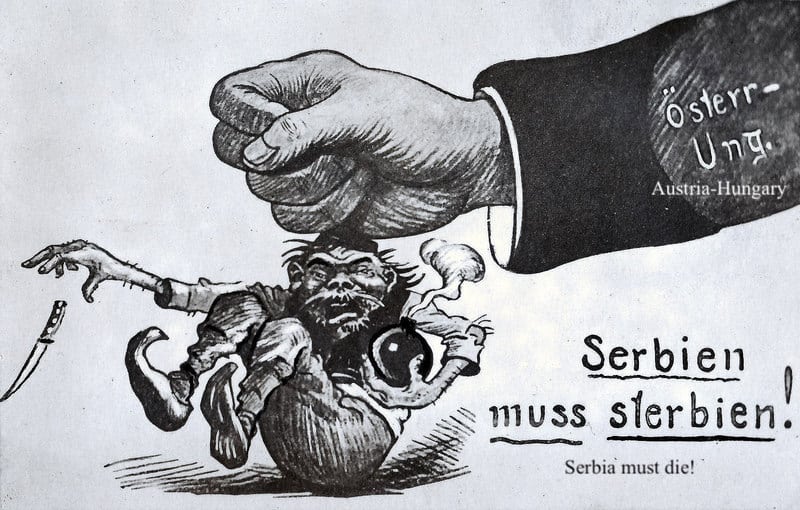
Analysis Questions:
- How are Serbians depicted in this political cartoon?
- Why are Serbians depicted this way? (aka why is Austria so angry?)
- Why would this aggression towards Serbia raise overall tensions in Europe?
Country 6: Germany
Context: Throughout the 18th and 19th centuries, many countries have been expanding their empires, in order to increase their wealth. Because you didn’t exist as a unified country until 1871 (after the German state of Prussia had defeated France in the Franco-Prussian War), you ‘missed out’ on developing your own empire and now hate to feel inferior. You first made an alliance with Austria-Hungary and then extended it to include Italy as well.
Primary Source: “Abridged Text of the Triple Alliance,” First signed in 1881 and renewed in 1902, Source
ARTICLE 1: The High Contracting Parties [of Germany, Austria-Hungary, and Italy” mutually promise peace and friendship, and will enter into no alliance or engagement directed against any one of their States. They engage to proceed to an exchange of ideas on political and economic questions of a general nature which may arise, and they further promise one another mutual support within the limits of their own interests.
ARTICLE 2. In case Italy, without direct provocation on her part, should be attacked by France for any reason whatsoever, the two other Contracting Parties shall be bound to lend help and assistance with all their forces to the Party attacked. This same obligation shall devolve upon Italy in case of any aggression without direct provocation by France against Germany.
ARTICLE 3. If one, or two, of the High Contracting Parties, without direct provocation on their part, should chance to be attacked and to be engaged in a war with two or more Great Powers non-signatory to the present Treaty, the casus foederis will arise simultaneously for all the High Contracting Parties. […]
ARTICLE 5. If the peace of any of the High Contracting Parties should chance to be threatened under the circumstances foreseen by the preceding Articles, the High Contracting Parties shall take counsel together in ample time as to the military measures to be taken with a view to eventual cooperation.
They engage henceforward, in all cases of common participation in a war, to conclude neither armistice, nor peace, nor treaty, except by common agreement among themselves […]
Analysis Questions:
- What does this treaty state each country must do if one of the others is threatened?
- Given that Austria-Hungary came into conflict with Serbia and was then threatened by Russia, how was Germany obligated to act?
Country 7: Italy
Context:
You are a relatively “young” country only becoming unified in 1871 (before that you were a group of separate states). You are quite weak and your government is not respected. Your position at the heart of the Mediterranean means that most countries want you to side with them. This opportunity for power came in the form of an alliance with Austria-Hungary and Germany.
Primary Source: “The Triple Alliance” 1891 Political Cartoon depicting Germany, Italy, and Austria-Hungary (from left to right) Source
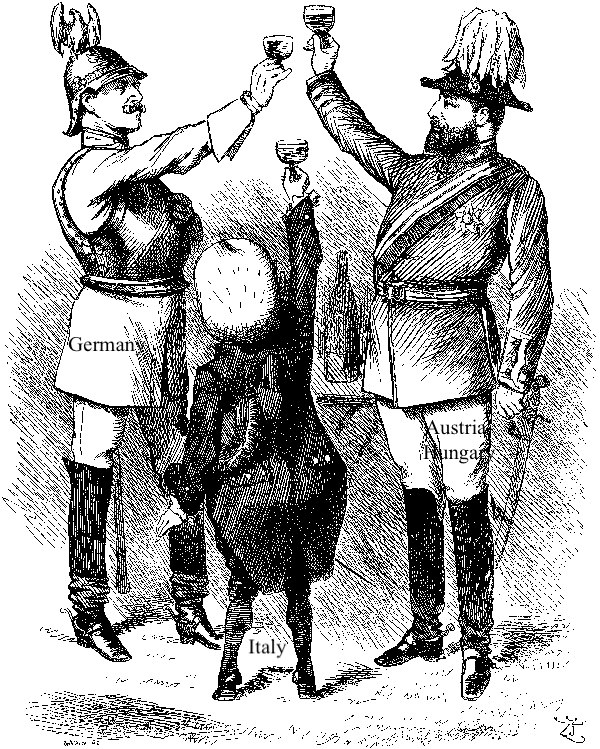
Analysis Questions:
- What is happening in this cartoon? How is Italy different from the other two members?
- What does this cartoon suggest about Italy’s power in comparison to Germany and Austria-Hungary?
Summary of Alliance

On the last page of the Google Form, students are presented with the above chart. As they discover through analyzing the various primary sources, this chart summarizes relationships between countries at the start of WWI. Knowledge of the alliances on both sides of the war is vital for students to understand before delving into the first events and battles of the war in the next lesson.

